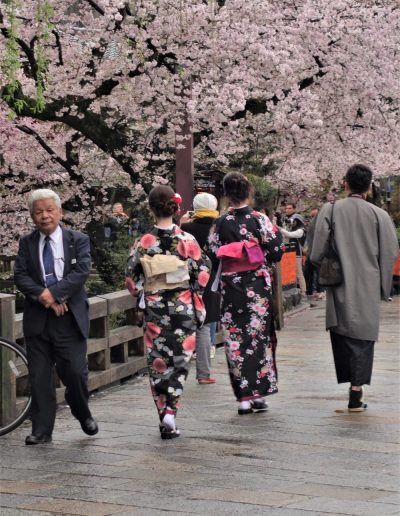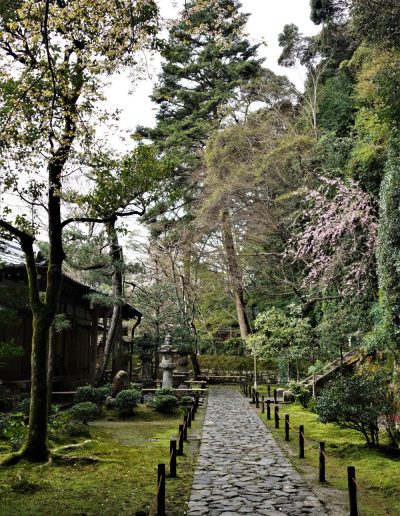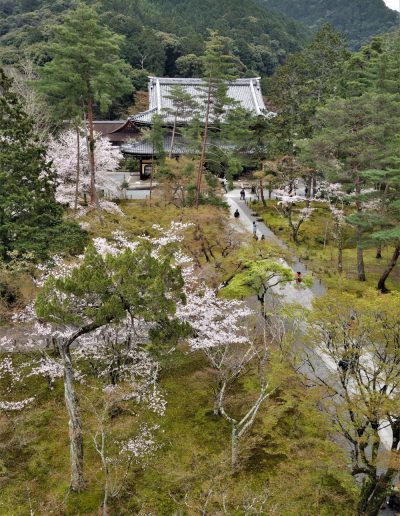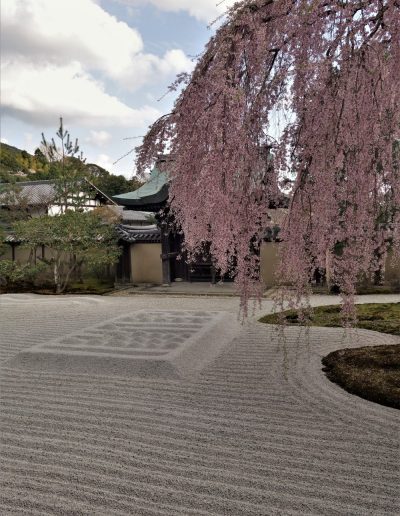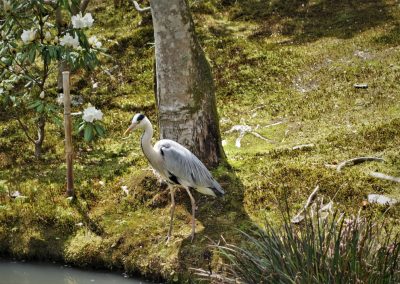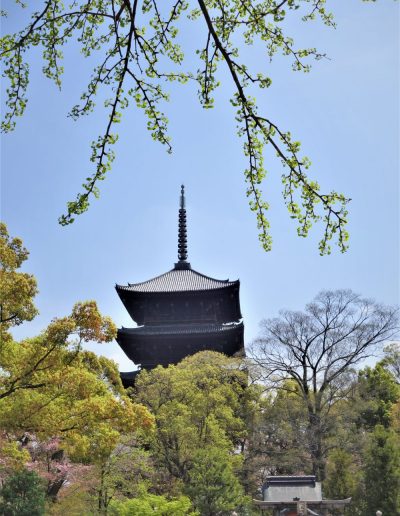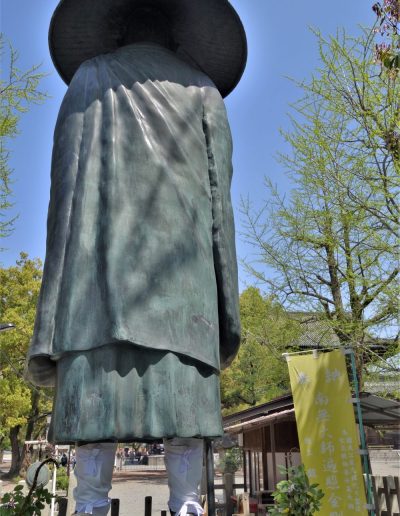- Caught the train from Takayama to Kyoto, via Nagoya. Settled in to our townhouse (called a machiya) conveniently located just south of the main station. It was great to have some space to spread out and be in Japanese style accommodation. Learning to respect the tatami mats, wear toilet shoes, fold up the futon every day.
- First evening we had dinner in Pontocho on the west bank of the Kama-gawa river. It was resplendent in blossom, beautifully lit.
- Kyoto was the imperial capital of Japan from 794 until 1868. It has a bewildering array of World Heritage monuments. There are 13 temples, three shrines, and one castle. These 17 sites have a total 198 buildings and 12 gardens. So there’s plenty to see.
- If you’re prepared to take the time, Kyoto is best approached in five districts. We spent our first and last days in the Central district, north then south of the central station. We spent an amazing day in the Eastern district of Higashiyama, a day visiting the Western district of Arashiyama, and a day visiting the famous temples of the Northern district. Even though we spent a week in Kyoto we didn’t have enough time to visit the Southern district.
- If you have the chance to visit Kyoto, go for as long as you can. It will be worth it.
- The first day was very wet so we explored areas close to our townhouse.
- Higashi Honganji is headquarters of the Jodo-Shinshu (True Pure Land) sect of Buddhism. Originally built in 1602 it’s a massive complex. It was rebuilt in 1859 after a series of fires. The main hall (Goeido) is Kyoto’s largest wooden structure and the adjacent Amidado Hall is almost as large.
- Next stop was Sanjusengeu-do, a long narrow building which houses 1,001 human-sized statues of Kannon, the Buddhist goddess of mercy. The effect is pretty amazing. In typical Japanese fashion, the site also has a Shinto shrine. We enjoyed sheltering from the rain under covered walkways painted in vermillion, looking out over the shrine and gardens.
- From there it was a short walk north to the geisha district of Gion, and the beautiful blossom-lined street of Shimbashi. It was fun to watch young Japanese people dressing up for hanami.
- The main sites of the Higashiyama district in eastern Kyoto sit within a fairly narrow strip between the east bank of the Kama-gawa river and the surrounding hills. We took a metro then taxi to the northern end of Higashiyama and spent the day walking south, back towards our townhouse.
- First stop was Ginkaku-ji Temple, the ‘Silver Pavillion’. In 1482, shogun Ashikaga Yoshimasa built his retirement villa here, modeling it on his grandfather’s retirement villa in northern Kyoto called Kinkakuji, the Golden Pavilion. Unlike the golden-gilded Kinkakuji, Ginkakuji was never gilded in silver. It was converted into a Zen temple after Yoshimasa’s death and has a beautiful moss garden and a unique dry sand garden.
- A charming feature of Higashiyama is the Philosopher’s Walk, a 2-km-long path named after the philosophy professor Kitarō Nishida. It provides a pleasant link between sites. During hanami it is lined in blossom and punctuated by photo shoots and food stalls.
- Honen-in is a small, peaceful temple with beautiful gardens.
- Nanzen-ji is an important Zen temple of the Rinzai sect. It has a massive Sanmon (main gate) and you can climb up to the balcony providing excellent views across the temple complex. The Hojo (main hall) has lovely interiors and surrounding gardens.
- Chion-in is head temple of the Jodo sect of Japanese Buddhism, with spacious grounds and large buildings. The Sanmon Gate is the largest wooden gate in Japan and dates back to the early 1600s.
- Walking via the peaceful park of Marugana-Koen, our next stop was Kodai-ji Temple built in 1606 in memory of Toyotomi Hideyoshi, a famous politician of the 16th C. It now belongs to the Rinzai sect of Zen Buddhism. There are gorgeous rock and gravel gardens and a bamboo grove.
- From here you can see the 24-metre concrete image of Kannon (Goddess of Mercy) at the adjacent Ryozen Kannon Temple, a war memorial built in 1955 to honour both Japanese and Allied soldiers killed in World War II.
- Yasaka Pagoda is a visible landmark in this area. It’s all that is left of Hokanji Temple which was founded in the 6th C.
- Last stop for the day was Kiyomizu-dera, the ‘Pure Water Temple’. It has a colourful main gate and pagoda, and is famous for the wooden stage that juts out from the main hall affording fabulous views of the wooded hills east of Kyoto.
- What a day.
- Next day we caught the train to the Arashiyama district in western Kyoto. Took it quite a bit slower after a big day yesterday.
- Tenryu-ji is the most important temple in this district. It’s ranked first amongst Kyoto’s five great Zen temples and was founded in 1339 by the ruling shogun Ashikaga Takauji. Fires and wars destroyed the original buildings and those you see today were built in the 19th C. The original gardens survived however, and are sublime. They were created by the famous garden designer Muso Soseki. We had an excellent Zen buddhist lunch in the temple restaurant.
- Another highlight in Arashiyama is the Bamboo Grove. It’s one of the most photographed sights in the Kyoto but the images can’t really convey the otherworldly feeling of being in a forest that sways with the wind.
- We decided to head back into central Kyoto and visit Nijo Castle. It was built in 1603 as the Kyoto residence of Tokugawa Ieyasu, the first shogun of the Edo Period. It’s surrounded by stone walls and moats. Inside it’s divided into the Honmaru (main circle of defense), the Ninomaru (secondary circle of defense) and the gardens. The palace buildings are arguably the best surviving examples of castle palace architecture from Japan’s feudal era, and the beautiful gardens were designed by Kobori Enshu.
- The northern district of Kyoto is very rich in temples. We decided to select a couple of sites to visit rather than running ourselves ragged trying to see them all. It worked well for us.
- The ‘Golden Pavillion’ of Kinkaku-ji is one of the top sites in Kyoto. The crowded #205 bus from the main station was a sign of things to come. It was packed as we entered the site and people jostled for position to get their ‘shot’. We took our time wandering through the beautiful gardens and as the crowds spread out it became very enjoyable. Kinkau-ji was originally built in 1397 as the retirement villa of the shogun Ashikaga Yoshimitsu, and became a Zen temple of the Rinzai sect after his death in 1408. Only the Golden Pavillion survived numerous fires and wars. Then in 1950 a young monk named Hayashi Yoken burnt it to the ground. The author Yukio Mishima wrote a novel called The Temple of the Golden Pavillion which is loosely based on this story. The Golden Pavillion you see today was built in 1955.
- We then visited Daitoku-ji, a large, walled complex dedicated to Zen buddhism. There are 24 sub-temples of which eight are open to the public. We managed to see five of these.
- Oubai-in dates back to 1562 when a small temple was built by the feudal warlord Oda Nobunaga in honour of his father. It has beautiful moss gardens and maple trees.
- Ryogen-in was constructed in 1502 and the temple’s main building is said to be the oldest standing in Daitokuji. It features five different dry landscape gardens. The largest has a field of raked white gravel representing the universe, and islands of rocks and moss representing a crane and a turtle, symbols of longevity and health. The temple also displays sliding doors (fusuma) painted with images of dragons and hermits.
- Daitoku-ji is a working temple and it was interesting to watch it going about its business. Monks bustled along the pathways and main structures like the Butsuden (main hall) could be admired from a distance.
- Kohrin-in was built as a family temple in 1520. It has a lovely dry garden which was being tended when we visited.
- Daisen-in is the most celebrated sub-temple of Daitoku-ji, founded in 1509. It preserves important architecture and has beautiful gardens. Photography is forbidden.
- Our last stop was Koto-in, built in 1601. It is famous for its bamboo-lined approach and its maple trees.
- On our last day we explored the southern part of central Kyoto, south of the train station.
- To-ji means “East Temple” and it was founded in the late 700s just after the capital moved to Kyoto. Along with the now defunct Sai-ji (“West Temple”) it guarded the south entrance to the city. It grew to prominence under Kobo Daishi, founder of the Shingon sect of Japanese Buddhism, who we learnt about at our next stop in Koya-san. The five-tiered wooden pagoda is the tallest in Japan (at 57 metres) and the spacious site has some beautiful halls. Most of the buildings seen today were rebuilt in the 17th C after many fires and wars. To-ji was a great place for a morning wander.
- We caught the train a little further south to Inari, to vist the Fushima Inari Taisha (shrine). It’s one of the top sights in Kyoto, famous for its thousands of vermillion coloured torii that straddle paths through the woodlands around Mount Inari (233 metres). Inari is the Shinto god of rice and Fushima is the most important of all Inari shrines. Once we got through the initial crush of people wanting their ‘shot’ of the torii we found it to be a lovely shrine. The crowds thinned out as we walked further along the paths and there were many interesting buildings beautifully painted, and heaps of fox Komainu. Normally the shrines are guarded by statues of dogs or lions but Inari shrines are guarded by foxes as they are thought to be the god’s messengers. Shrines often have food stalls (at least at this time of year) and we feasted on octopus balls (takoyaki) and omelette (okonomiyaki). It was a great end to our stay in Kyoto.







